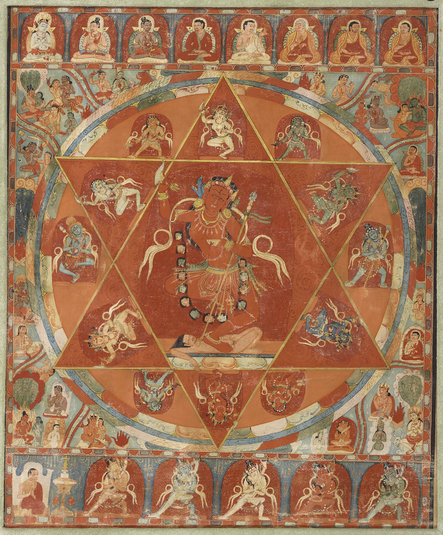
Item: Mandala of Vajrayogini (Buddhist Deity) - Vajravarahi
| Origin Location | Tibet |
|---|---|
| Date Range | 1200 - 1299 |
| Lineages | Kagyu, Taklung (Kagyu) and Buddhist |
| Size | 42.50x35.50cm (16.73x13.98in) |
| Material | Ground Mineral Pigment on Cotton |
| Collection | Publication: Wisdom Publications, Calender |
| Catalogue # | collection of L. Fournier |
Classification: Deity
Appearance: Semi-Peaceful
Gender: Female
Vajravarahi Mandala according to the Taglung Kagyu Tradition, circa 1210. The last lineage teacher in the top register is Taglung Tangpa Chenpo, Tashi Pal (1142-1209/10 [p2649]). An unidentified monastic donor figure is located in the lower left corner.
Video: Vajravarahi Mandala Comparison (HAR on Patreon)
Deity & Mandala: At the center of the composition is the female Buddhist figure Vajravarahi belonging to the Vajrayogini class of meditational deities. She is framed within a large double tetrahedron depicted as two intersecting triangles. There are twelve secondary figures surrounding Vajravarahi contained within three concentric circles of lotus petals, vajra scepters and multi-coloured flames of wisdom fire. The two figures standing upright at the sides are male and do not belong to the mandala proper. On the left is Heruka Hevajra. On the right side is Heruka Chakrasamvara. The lineage source for Vajravarahi is likely to be either Tilopa or Naropa based on the context of the overall mandala. Both siddhas are known to have transmitted several different mandala configurations. (See a comparable example: HAR #101337. For more information on Vajravarahi see HAR #94 ).
Eight Charnel Grounds: Surrounding the mandala circle are the eight great charnel grounds each has a special tree, cloud, pond, naga and two types of worldly gods. 'Furthermore, there are headless corpses, hanging corpses, lying corpses, stake-impaled corpses, heads, skeletons, jackals, crows, owls, vultures, and zombies making the sound, "phaim". There are also siddha with clear understanding, yaksha, raksha, preta, flesh eaters, lunatics, bhairava, daka, dakini, ponds, fires, stupa, and sadhaka. All of these fill the charnel grounds.' (Konchog Lhundrub 1497-1557, written in 1551).
The 'siddha with clear understanding' are represented by laypersons or monastics with some recognizable. The Sakya and Kagyu traditions generally have specific siddhas associated with a particular cemetery and a direction. The Nyingma and Gelug traditions generally include a generic unspecified siddha figure.
Upper Register: In the upper register beginning on the left side is the Marpa Kagyu lineage of teachers. The figures are Vajradhara, Tilopa, Naropa, Marpa, Milarepa, Gampopa, Pagmodrubpa, and Taglung Tangpa Chenpo (1142-1209/10). The dating of the composition is based on both the dates for the lineage teacher Tangpa Chenpo, along with the early Indian style of painting popular in Tibet during the 12th and 13th centuries.
Taglung Lineage: 1. Shakyamuni Buddha 2. Vajradhara 3. Tilopa 4. Naropa 5. Marpa Chokyi Lodro 6. Milarepa Zhepa Dorje 7. Gampopa Sonam Rinchen 8. Pagmodrubpa Dorje Gyalpo (1110-1170 [p127]) 9. Taglung Tangpa Chenpo, Tashi Pal (1142-1209/10 [p2649]) 10. Kuyalwa (Onpo) Rinchen Gonpo (1191-1236 [p1784]) 11. Sanggye Yarjon (1203-1272 [p1818]) 12. Tashi Lama (Mangala Guru, 1231-1297 [p8428]) 13. Others....
Lower Register: In the lower register are the Five Chakrasamvara Heruka deities: yellow Ratna Heruka, blue Vajra Heruka, white Buddha Heruka, red Padma Heruka, and green Karma Heruka. These five are also know by their buddha associated names: Ratnasambhava, Akshobhya, Vairochana, Amitabha and Amoghasiddhi. At the lower left corner is a monastic figure likely to be the donor for the composition. The student Kuyalwa (Onpo) Rinchen Gonpo (1191-1236 [p1784]) is a possible candidate for an identification of the donor figure.
Inscription on Reverse: An inscription on the reverse of the painting has the three letters representing the Body, Speech and Mind of realization, om a hum. This is followed by the sarva vidya mantra. Again followed by the Ye dharma formula. The 4th and 5th lines have the mantra of Vajrayogini in the form known as the Three Oms based on the union of the essence and near essence mantras. The lower four lines contain the Patience Verse.
Sanskrit: Vajravarahi Tibetan: Dor je pag mo
Tibetan: Dor je pag mo
Jeff Watt 8-2022
Wisdom Calendar 2001 - October (full catalog list)
Buddhist Deity: Vajrayogini, Vajravarahi Art History
Mandala: Mandala Main Page
Tradition: Kagyu Deity Paintings
Buddhist Deity: Vajrayogini, Vajravarahi Main Page
Buddhist Deity: Vajrayogini Main Page
Painting Style: Indian Style Painting (In Tibet)
Buddhist Deity: Deities (Female)
Buddhist Deity: Vajrayogini Art History
Buddhist Deity: Vajrayogini (Double Dharmakara)
Mandalas: Kagyu
Tradition: Taglung Kagyu Main Page
Mandalas: Cemeteries on the Outside
Buddhist Deity: Vajrayogini, Varahi (Painting Masterworks)
Buddhist Deity: Vajrayogini (Early Paintings)
Buddhist Deity: Vajrayogini, Varahi (Sow Head on the Right Side of the Face)
Buddhist Deity: Vajrayogini, Varahi (Mandala Masterworks)
Mandala: Masterworks Page
Buddhist Deity: Vajrayogini (Comparison #77206 & 101337)
Collection: Sotheby's, Painting (September 2022; New York)
Collection: Sotheby's, September, 2022 (Curator's Selection)
Collection: Sotheby's New York (Painting, September 2023)
Painting Style : Indian (Deities)

